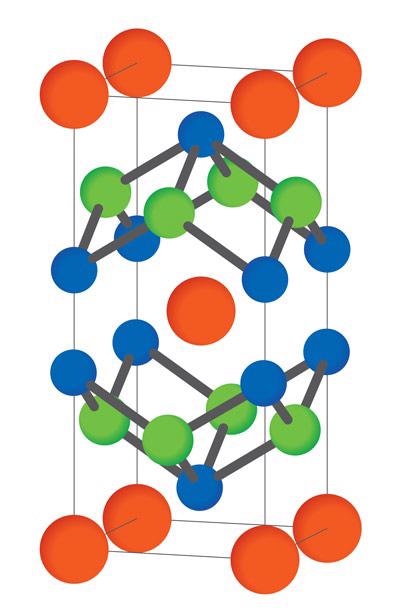Mar 8 2021
Physicists from RIKEN have found how interactions between electrons have the ability to stabilize a repeating arrangement of swirling magnetic patterns called skyrmions, which could enable these structures to be leveraged further.
 The crystal structure of gadolinium ruthenium silicide, which can host a square lattice of swirling magnetic skyrmions (orange = gadolinium; green = ruthenium; blue = silicon). Image Credit: © 2021 Y. Yasui et al.
The crystal structure of gadolinium ruthenium silicide, which can host a square lattice of swirling magnetic skyrmions (orange = gadolinium; green = ruthenium; blue = silicon). Image Credit: © 2021 Y. Yasui et al.
An electron acts like a miniature magnet due to its spin. In the case of a skyrmion, several such spins are arranged in a swirling pattern resembling a small tornado. Skyrmions are particles that exhibit high potential to carry information in a completely new generation of low energy, high density data storage devices.
Skyrmions act as if they are discrete particles, and numerous skyrmions can arrange themselves into a regular grid inside some types of material. However, there is still a debate among scientists on the way these stable skyrmion lattices form.
Yuuki Yasui and colleagues from the RIKEN Center for Emergent Matter Science endeavored to find about skyrmion lattices in-depth and analyzed a metallic material known as gadolinium ruthenium silicide (GdRu2Si2).
The magnetic properties of the material mainly arise due to the electrons from the gadolinium atoms, while the ruthenium atoms provide 'itinerant' electrons that are more mobile.
The researchers earlier discovered that when a magnetic field is applied to the material, it was possible to develop a square lattice of skyrmions arranged in a grid pattern at intervals of around 2 nm.
As part of the new study, the researchers employed a technique known as spectroscopic-imaging scanning tunneling microscopy (SI-STM) to investigate the itinerant electrons in GdRu2Si2.
The material was cooled to −271°C and a range of magnetic fields were applied to produce different magnetic patterns.
SI-STM measurements revealed that variations in the magnetic patterns of the material were reflected in the way itinerant electrons were distributed.
Most importantly, the researchers also observed the skyrmion lattice pattern to be imprinted on the itinerant electrons of the material.
This was because of interactions between the spins of itinerant and localized electrons.
The team proposes that these interactions could have a crucial role to play in the formation of the square skyrmion lattice.
The proposed mechanism stabilizes skyrmion lattices.
Yuuki Yasui, Center for Emergent Matter Science, RIKEN
In addition, the researchers carried out theoretical calculations based on the interactions between itinerant and localized electrons, to estimate how the itinerant electrons are distributed in the material under various magnetic fields. These distributions were quite similar to the patterns seen by SI-STM, which supports the mechanism put forward by the research team.
Apart from offering clues related to the way skyrmion lattices are stabilized, the study also demonstrates that SI-STM can be employed to indirectly monitor the behavior of skyrmions.
This could provide researchers with a useful tool to study skyrmion lattices in other materials.
Yuuki Yasui, Center for Emergent Matter Science, RIKEN
Journal Reference:
Yasui, Y., et al. (2020) Imaging the coupling between itinerant electrons and localised moments in the centrosymmetric skyrmion magnet GdRu2Si2. Nature Communications. doi.org/10.1038/s41467-020-19751-4.